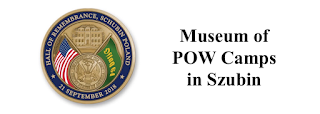On Tuesday April 26th, The Zenon Erdmann Museum of Szubin Land (Muzeum Ziemi Szubińskiej im. Zenona Erdmanna w Szubinie) hosted a lecture by Mariusz Winiecki. The title of the lecture “Under, Over and Through the Wire” was inspired by a chapter title in Stephen Dando-Collins’ upcoming book, currently under the working title: “THE BIG BREAK: The Greatest WWII Escape Story Never Told”. The lecture contained known and locally previously unknown facts about the escapes from Oflag XXI-B and Oflag 64 POW camps in Szubin. Attendees, mostly residents of Szubin, heard many interesting stories including one about the very first escapee from Szubin, Ronald Clarence “Ron” Jeffery, an English soldier and an agent of British and Polish intelligence during World War II, described by the Gestapo as “one of the foxiest devils in Europe”.
The story of Sergeant Philip Wareing, the first successful home run from Szubin, was told, as well as the tragic story of a member of the mapping intelligence department, Pilot Officer Peter Lovegrove. It was illustrated with previously unseen photographs of his funeral at the Szubin cemetery. These photos were coincidentally sent just two weeks ago by Bill Robertson who spontaneously shared the YMCA logbook of his great grandfather Lance Corporal John Conway. The culmination of this part of the lecture focused on the Asselin Tunnel break out on the night of March 5th/6th involving 33 men, which in fact could be named as “The Great Escape” prelude. Among the Eddie Asselin team of escapees were: Aiden Crawley, Prince Palmer, Duke Marshall, Danny Król, Otto Černy, Thomas Daniel Calnan, Robert Kee and Harry ‘Wings’ Day and others. The story of two sewage wagon escapees, Josef Bryks and B. G. Morris, which was well-known in Szubin, was mentioned as well. All these attempts would not have been possible without the brave residents of Szubin who, risking their lives, cooperated with the camp escape committee. The help was organized spontanously and under the auspices of a wartime underground organization of the Polish Scouting Association called “Gray Ranks” (Szare Szeregi). The fate of several Asselin Tunnel escapees was reviewed with examples of the most successful escapees, who covered a good distance before being caught, like Crawley on the Austrian border between Munich and Innsbruck, or Calnan and Kee at Cologne, or another tragic one like Thalbitzer and Buckley who were drowned making the short crossing to Sweden from Denmark via a two-man canoe.
Oflag 64 also abounded with several escape attempts, of which the most widely known was the escape through the wire via the nearby evangelic cemetery and the brilliant “fake drunk party” operation to escape from the cooler. Both escapes were organized by one of the senior officers, John H. (Jack) Van Vliet Jr. together with three lieutenants – Frank N. Aten, Roy J. Chappell, William F. Higgins and with one more would-be escapee in the second one – Richard W. (Dick) Secor. The arduous preparation of the gate walk-out scheme by Howard Holder and George Durgin (later replaced by Andy Johnson) were shared with the attendees at the lecture. Also described was the engineering of William Cory’s tunnel developed westward from barrack 3A. The tunnel had the luxury of air conditioning and a suction device which efficiently sucked the water out, both courtesy of Louis W. Otterbein, the camp handyman. Unfortunately these two projects were crushed by the ‘no escape’ order given by the SAO after the execution of the “Great Escapees” from Stalag Luft III. The final portion of the lecture brought the story of the plan of probably the greatest escape in history. The Oflag 64 escape committee was informed, via coded letters from MIS-X, about the possibility of evacuating the entire camp by twenty B17 aircraft able to land on the field at the north edge of the camp. The plan was developed in the Pentagon with the cooperation of the British and American armed services, and priority photographic flights were ordered over Szubin from London. This hard-fought plan for the perfect escape was rejected by US Secretary of War, Henry Stimson, as too risky just a couple of days before D-Day.
The lecture ended with the presentation of never locally seen photos, courtesy of the International Committee of the Red Cross, dating back to 1940 before the camp became Oflag 64. The meeting was also the perfect occasion for a special donation to the Museum from one of the descendants of a former POW of Oflag 64. The original first issue of “The Oflag 64 Item” camp newspaper was donated to the community of Szubin by Susanna Bolten Connaughton who visited Szubin in January 2015. Susanna is the daughter of former Oflag 64 Prisoner of War, Seymour R. Bolten, the man who together with Frank Diggs and Larry Phelan worked in the local printing house of Altburgund for 15 months, between November 1943 and January 1945, editing the internal camp newspaper.
More photos at the website of Muzeum Ziemi Szubińskiej or Szubiński Portal Informacyjny.
"Wielkie i małe ucieczki" - article by Remigiusz Konieczka in Pałuki no 1264 (18/2016).
© Mariusz Winiecki























